

In addition to familiarising themselves with individual aspects focusing on the disaster risk management planning, participants need to understand the larger framework within which disaster risk management is placed. The significance of linking disaster risk management with institutional frameworks and policies for disaster risk management at the regional, city or local level is highlighted through this section.

A sample matrix which may be used to illustrate various linkages between management systems of cultural heritage site, disaster risk management of the area/region in which the site is located and the specificdisaster risk management plan for the cultural heritage site
The teaching strategy for this section is based mostly on delivering core content through lectures with the instructor highlighting the key gaps in coordination between various institutions/departments and the need for establishing connections between disaster risk management and the larger planning and management framework. At this stage, participants are either almost at the concluding part of the course or in the process of completing their individual or group case studies. This module can thus also be used to summarise a major portion of the course for participants when establishing links between disaster risk management planning and the greater purview of site and heritage management and policy.
Disaster Risk Management Plan for Cultural Heritage Sites Lecture 19, International Training Course, 2008
Instructor: Rohit Jigyasu
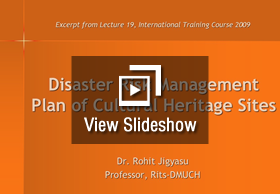
Secondary case studies may be used extensively at this stage to highlight how the disaster risk management plan for a cultural heritage site can potentially link up with other planning frameworks at the urban and regional levels. Potentially, thematic lectures for this section could link to a workshop organised as an open forum, where participants may interact directly with various stakeholders involved.
Integrating Disaster Risk Management into the Management system for World Heritage Monument Zones of Kathmandu Valley, International Training Course, 2010
Instructor: Kai Weise
Read More...
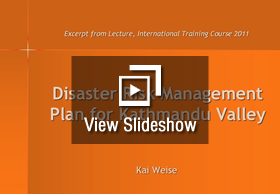
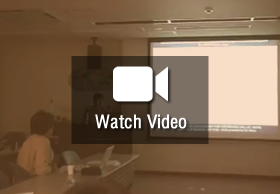
PHILIPPINES: The DRRM Act of 2010 and the Climate Change Act of 2009 - Implementation Issues at the Local Level, Lecture 19, International Training Course 2011
Instructor: Jerry Velasquez
Read More...
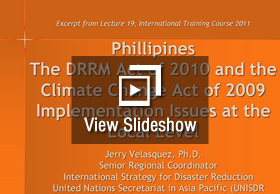
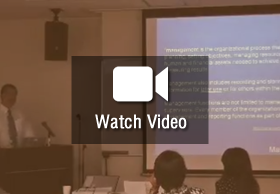
The International Context for Conservation and International Initiatives on Disaster Risk Management for Cultural Heritage
Linking with larger institutional framework and methods for post disaster recovery and rehabilitation of cultural heritage at international/national/regional levels.
International Training Course, 2012
Instructor: Joseph King
Read More...
Participants working on individual case studies to prepare a disaster risk management strategy could use the frameworks introduced to them through the presentations and secondary case examples to refine their own work. An open session where the participants discuss their individual sites could be useful to highlight various aspects of this subject.
Integrating Disaster Risk Management into the Management system for World Heritage Monument Zones of Kathmandu Valley, International Training Course, 2010
Instructor: Kai Weise
The instructor introduced the Kathmandu Valley, inscribed on the List of UNESCO World Heritage Sites in 1979. The site was inscribed on the List of World Heritage in Danger in 2003 following extensive damage after an earthquake. The World Heritage Committee therefore requested the State Party to submit new legally redefined core and buffer zones for the seven monuments zones and to establish an integrated and comprehensive management plan for the area.
The instructor took the participants through the overall management process of urban heritage sites, through the case of Kathmandu Valley. The various site management issues were explained, and the streamlining of management within the overall planning framework was highlighted through the example of Kathmandu Valley. Additionally the need to integrate disaster risk management into the overall planning framework was highlighted.
The need for a collaborative approach to disaster risk management in Kathmandu Valley, due to the complexity of issues involved in this type of zone, was highlighted. Any management process for the area needs to account for various questions, for instance:
The municipal processes dealing with the planning and monitoring of heritage conservation and disaster risk management must be transparent, effective and must include controls and incentives. Links between the two must be strengthened at various levels. Besides the need for representation of the heritage conservation sector in the disaster management council and committees at central and district levels was highlighted. The lecture also stressed the need for engaging communities in the process.
The recent cooperation agreement between owners of cultural assets and their neighbours (2000~) was discussed. This agreement was drawn up between owners of cultural assets and their neighbours to enable rapid and efficient response to a fire in cooperation with each other.

PHILIPPINES: The DRRM Act of 2010 and the Climate Change Act of 2009 - Implementation Issues at the Local Level, Lecture 19, International Training Course 2011
Instructor: Jerry Velasquez
This session centred on equipping participants with the tools for integrating disaster risk management and Climate Change Adaption (CCA) into existing local planning processes like land use and development planning and also securing and assessing the necessary information for the same on hazards, vulnerabilities and exposure.
Disaster risk reduction and CCA should be rooted in local realities and development processes. For local governments in the Philippines, the authority and system of comprehensive land use planning provides the opportunity for disaster risk management and CCA mainstreaming. With the advent of Disaster Risk Reduction and Management Act of 2010 and the Climate Change Act of 2009, the time and institutions are ripe for this kind of integration. However the latest figures from the Philippines Government show that many cities and municipalities prepare their respective comprehensive land use plans, and most of these have not integrated the tools of risk reduction, except for the simple hazard maps in delineating the use of land resource in their jurisdiction.
Opportunities for promoting protection and management of cultural heritage through the implementation of the Disaster Risk Management and Climate Change Laws were explained to the participants.
